The 2019/20 UEFA Champions League marked the first time since the 2006/07 season that La Liga was without a representative in the semifinals. Since 2005/06, La Liga teams have claimed 10 of the 30 available spots in the final, with the league lacking a finalist on just seven occasions.
Over the past 15 seasons, Real Madrid and Barcelona have each claimed four Champions League titles giving each two more than their nearest competitor, Bayern Munich.
But after the first leg in the 2020/21 Champions League Round of 16, Real Madrid was the only one of the four La Liga teams to claim a victory, beating Atalanta 1-0 despite playing a man up for the majority of the game. Barcelona was humiliated by PSG, Atlético Madrid was very timid in their 1-0 loss to Chelsea and Sevilla was beaten 3-2 at home by an energetic Borussia Dortmund team.
La Liga fans have seen the transitions in personnel amongst their top teams. Those moving pieces, as well as recent Champions League results beg the question, “is La Liga in decline?”
It’s a complex question, but one we’ll address in this data analysis. You may recall a Total Football Analysis article called “The Art of Overachieving” where I looked at the salaries and transfer money spent on players, as well as looking at the data of players in and out. I’ll leave it to you to go back and read that article for the evidence that La Liga has not lacked investment over the past few years. Instead, this data analysis will look at La Liga teams from a tactical standpoint, examining whether the turn to more direct and transitional football has jeopardized their contention for the Champions League title.
Attacking efficiency
The first area we’ll look at is attacking efficiency and the vertical aspect of the game. With the game moving towards possessions with fewer passes and less time of control on goal-scoring moves, we want to see if La Liga’s top teams are behind the curve in these aspects of the game.
In each of the visualizations in this article, I’ve used a colour-coded system to label La Liga sides in orange and each other country in blue. You’ll also notice half of the teams have a star while the other half are represented with a filled circle. The shapes represent the first leg result in the Round of 16. If a team’s point is represented with a star, note that they won the first leg, whereas a circle indicates the losing team. There were no draws, so the two shapes are enough to represent all 16 teams.
Turning to our first graph on attacking efficiency, we’re looking at the percentage of counterattacks and positional attacks that end with shots. Here we see that La Liga teams are actually doing quite well. In the current campaign, Barcelona leads the way in their percentage of positional attacks ending with the shots while finishing second to Bayern Munich in counter-attacking efficiency. Sevilla isn’t far behind and Real Madrid is more or less at the median in each category. Meanwhile, Atlético Madrid rates 13th in counterattacking efficiency and hits the median in the percentage of positional attacks leading to shots.
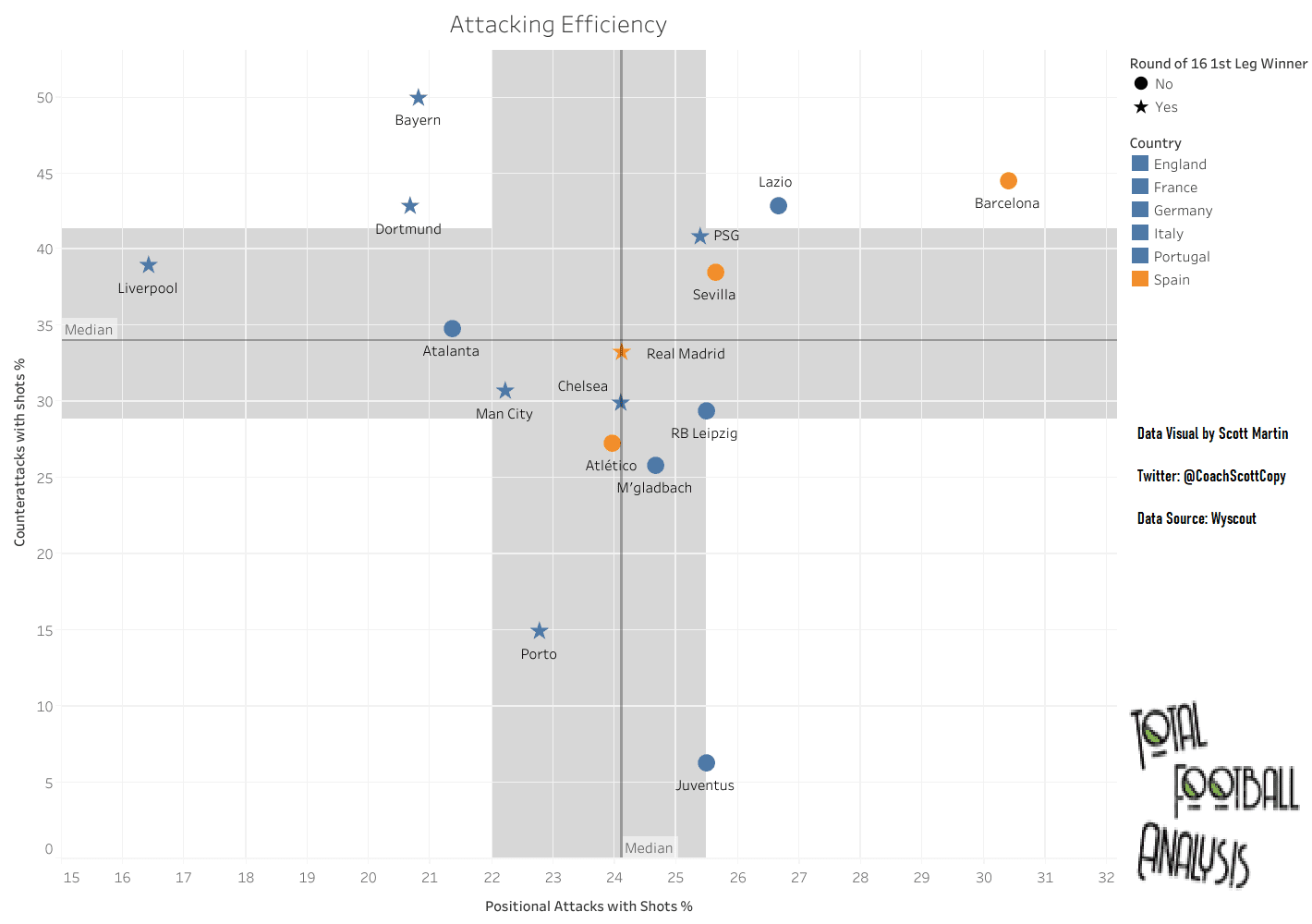
There really aren’t any issues on that graph, except perhaps Atlético Madrid’s poor counterattacking efficiency, which is one of the big surprises.
Next up is progressive actions. On a per 90-minute basis, we’re looking at progressive runs and progressive passes. Wyscout’s website can provide the full definition for the statistics, but suffice it to say that progressive actions are any events that significantly progress the ball higher up the pitch. The closer to the opponent’s goal, the lower the distance required for progression.
In terms of progressive actions, Real Madrid is not only tactically balanced but highly successful in each category. That might seem odd if you’ve watched their seven Champions League appearances this season, but the team’s issues are typically in the most advanced parts of the pitch. They’ve had very few issues advancing into the attacking third.
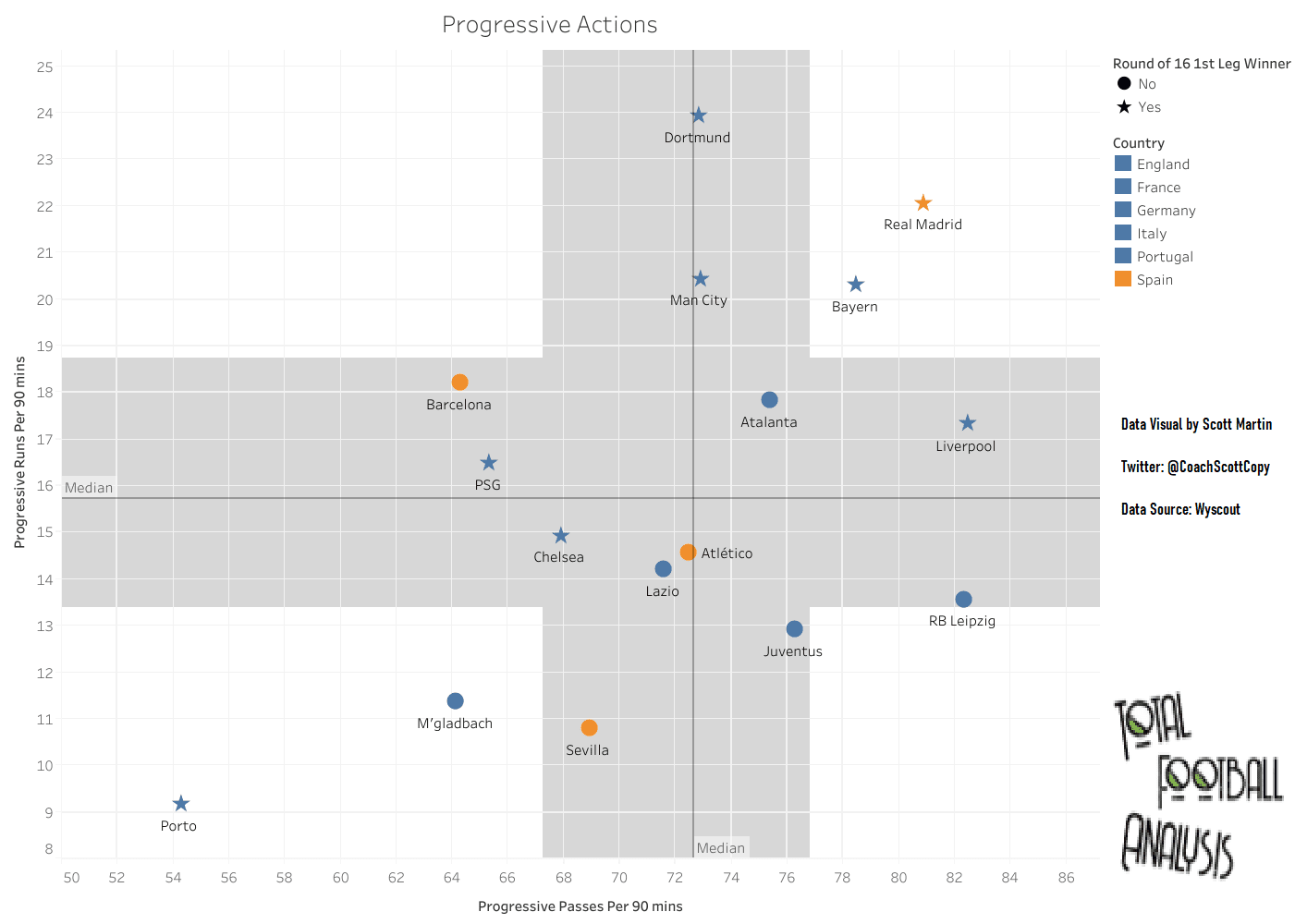
Looking at the other La Liga teams, Atlético Madrid is fairly average in both categories, whereas Barcelona and Sevilla are below average in progressive passes. Remember that these are categories with distance requirements. With Barcelona’s network of closely linked players and the heavy reliance on short and intermediate-range passes, a poor showing in the progressive passes category really shouldn’t be too surprising. That said, since the side doesn’t enjoy the same level of qualitative and socio-affective dominance that they’ve enjoyed over the past decade, their poor rating in progressive passes is also an indication of their inability to adapt to their changing circumstances. That’s not to say they should throw out a tried and true philosophy, but only that tactical tweaks to take advantage of organized opponents seems to be lacking.
Sevilla’s below-average showing in both categories is rather surprising. Given their propensity to attack in the spacious quarters of the wings, my initial assumption was that they would rate fairly well in progressive runs while holding their own in progressive passes, which certainly isn’t the case among Europe’s elite.
Our final visual for the section is with regards to ball losses. The idea here is to get a sense of where each team tends to lose possession of the ball, which gives an indication of match initiative and the necessary defensive tactics to counter the opposition. Our visual is situated like a football pitch with low losses at the bottom of the image. Those statistics lead into medium losses, followed by high losses at the very top of the chart.
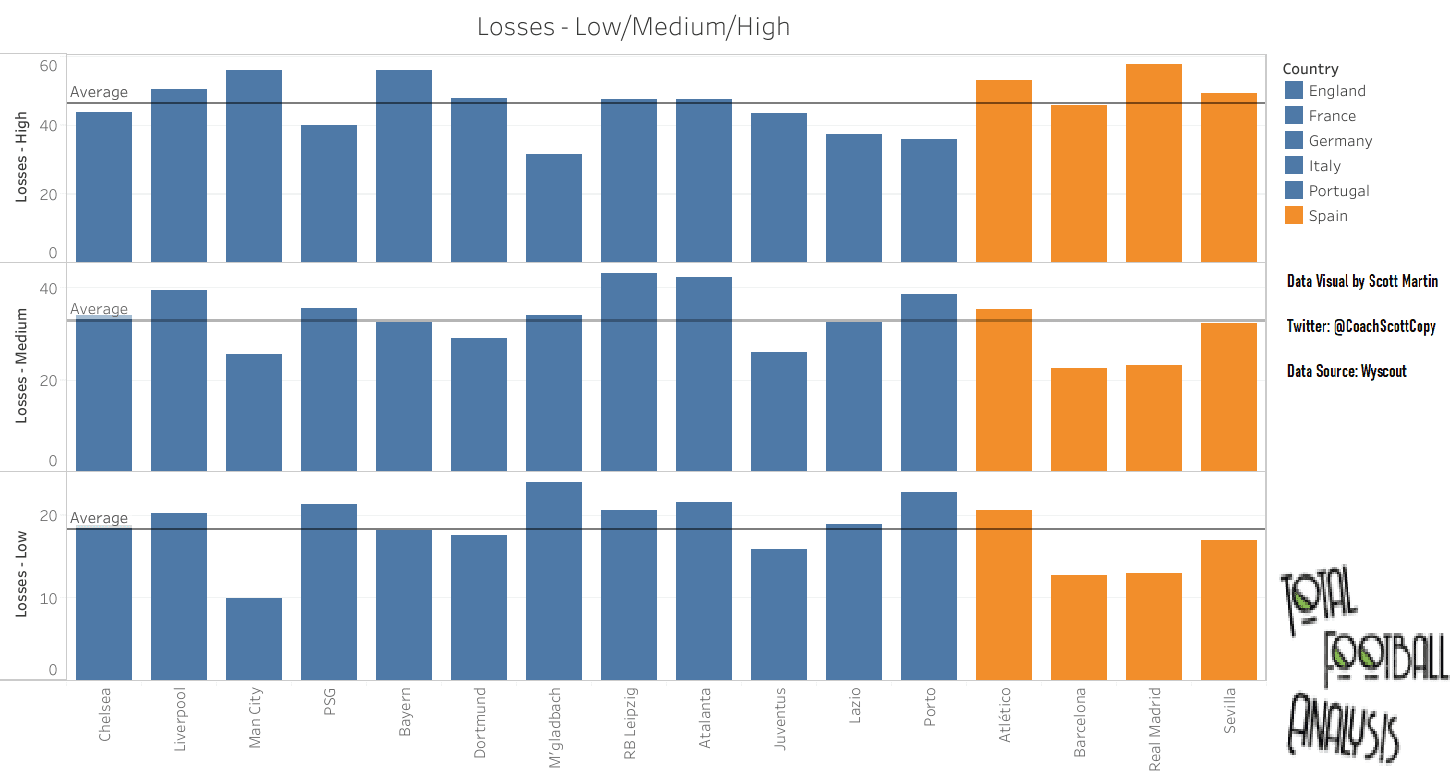
Interestingly enough, Atlético Madrid is the only La Liga club to earn an above-average number of low losses, which is largely due to their deep defending, particularly against Liverpool and Chelsea. Moving into the middle third of the pitch, we again find that Atlético is slightly above-average in medium losses, but they’re also joined by Sevilla, which is essentially at the median line. Real Madrid and Barcelona have improved upon their low loss ratings, taking the top two spots in the medium lost category.
It’s when we get to the high losses that things get interesting. Real Madrid claims the spot for the most high losses and Atlético aren’t far behind. Sevilla is now above average in the category while Barcelona hits the median.
A few things that we can summarize from this chart, as well as the section as a whole, are that Barcelona and Real Madrid tend to enter the final third very efficiently and Sevilla are rather press-resistant as well. Atlético Madrid aren’t quite as clean in the attacking phases and are one of the least press resistant among the final 16 teams. Even despite their above-average losses in the first 2/3 of the pitch, they’re still highly effective in reaching the final third, a quality shared by all four of La Liga’s representatives.
So, in terms of attacking efficiency involving progression, La Liga’s teams rate very well. If there’s an issue in this aspect of the game, it’s because of the way it’s linked to a second or third aspect, such as attacking third engagement.
Around the box
Knowing that La Liga’s top teams are fairly proficient in reaching the attacking third of the pitch, our next step is to figure out what’s happening when they get there. We’ll look at how they enter the box, as well as how they perform as they attack the goal and what implications a venture into the final third has on that transition from attacking the opponent to attacking the goal.
The first thing we’ll look at is box entries, plotting crosses vs runs into the penalty area. Again we find that Real Madrid, La Liga’s only team to record a win the first leg, offers the greatest sense of balance. That said, they do rate second to Sevilla and crosses into the box. Atlético is some distance off in terms of the number of crosses they send per match, but they still rate fifth in the category,
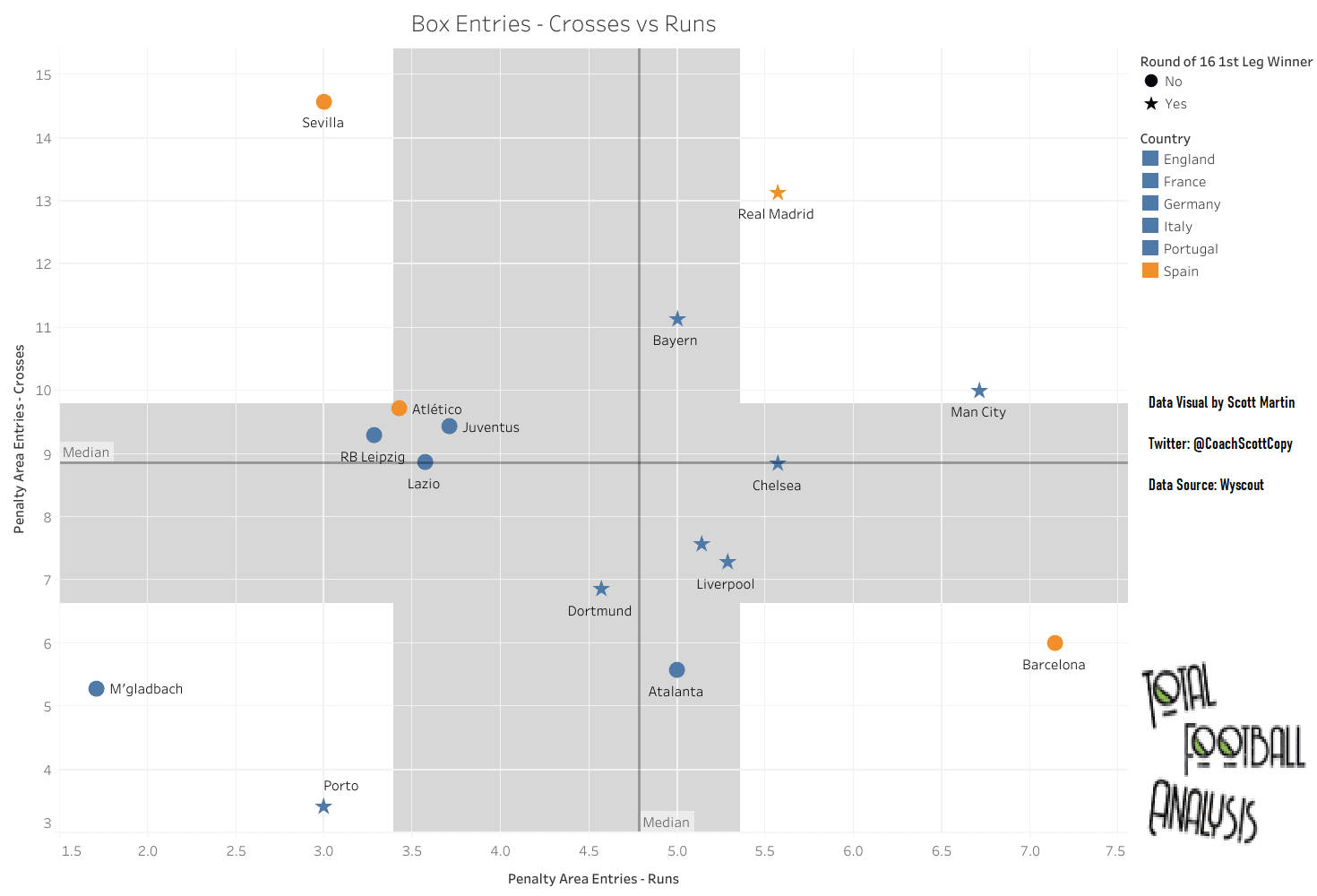
With the exception of Real Madrid, the thing that stands out most is the lack of balance in the way La Liga teams are entering the box. The lack of a diversified approach makes them more predictable in the final third. We all know that Barcelona enjoys running into the box, especially from the half space. We all know that when Messi drops deep into midfield, he’s looking for someone to make a run into the box and will attempt a vertical entry. We all know that Sevilla is going to target their two forwards and that If you can stop Atlético’s counterattack, they’ll most likely defer to a cross.
These very predictable outcomes make it more difficult for La Liga’s teams to find success in the final third of the pitch, especially in the knockout rounds of the competition. Forcing one action or the other may have produced success when La Liga sides enjoyed a very clear qualitative advantage over their opponents, but is gone.
When they get into the box, we do see that, on average, La Liga teams do tend to have more touches in the penalty area than their competitors. Barcelona rates first, followed by Manchester City, Real Madrid and Atlético Madrid. Sevilla are a little ways off, but still very close to the 16 team median.
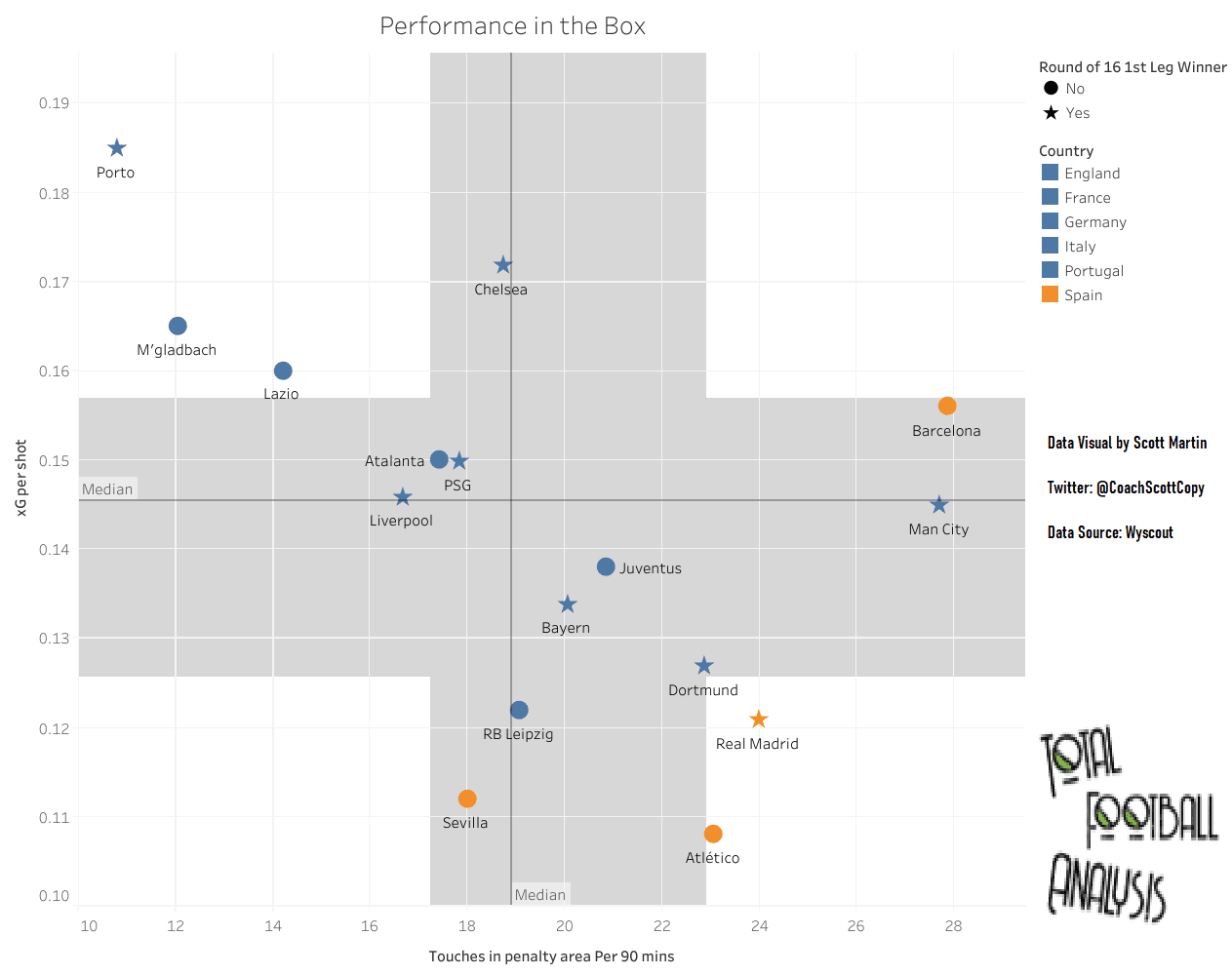
It’s when you get to the xG per shot that things get ugly. On the surface, Barcelona’s mark of 0.156 is quite good, but that’s before you account for the 4.56 total xG for the Champions League leading six penalty kicks they’ve received. Subtract that from their total and the mark is fairly average. Also bringing down the xG per shot average is the fact that Barcelona leads the Champions League with 16.99 shots per 90 minutes.
Then you have the other three La Liga teams bringing up the rear. To their credit, Real Madrid records the second-most shots among this collection of knockout stage clubs, attempting 14.77 P90. That’s also part of the issue for them and each of La Liga’s four competitors. Of the original 32 team field, Barcelona rates first in shots per 90 minutes, Real Madrid is 3rd, Sevilla’s 5th and Atlético Madrid is 12th. So they are taking shots but of a lesser quality than the opposition.
One of the primary influences in the low shot quality, in addition to the sheer volume per match, is the way opponents defend against them. In this next graph, we’re looking at PPDA (passes per defensive action) against and xG per shot against.
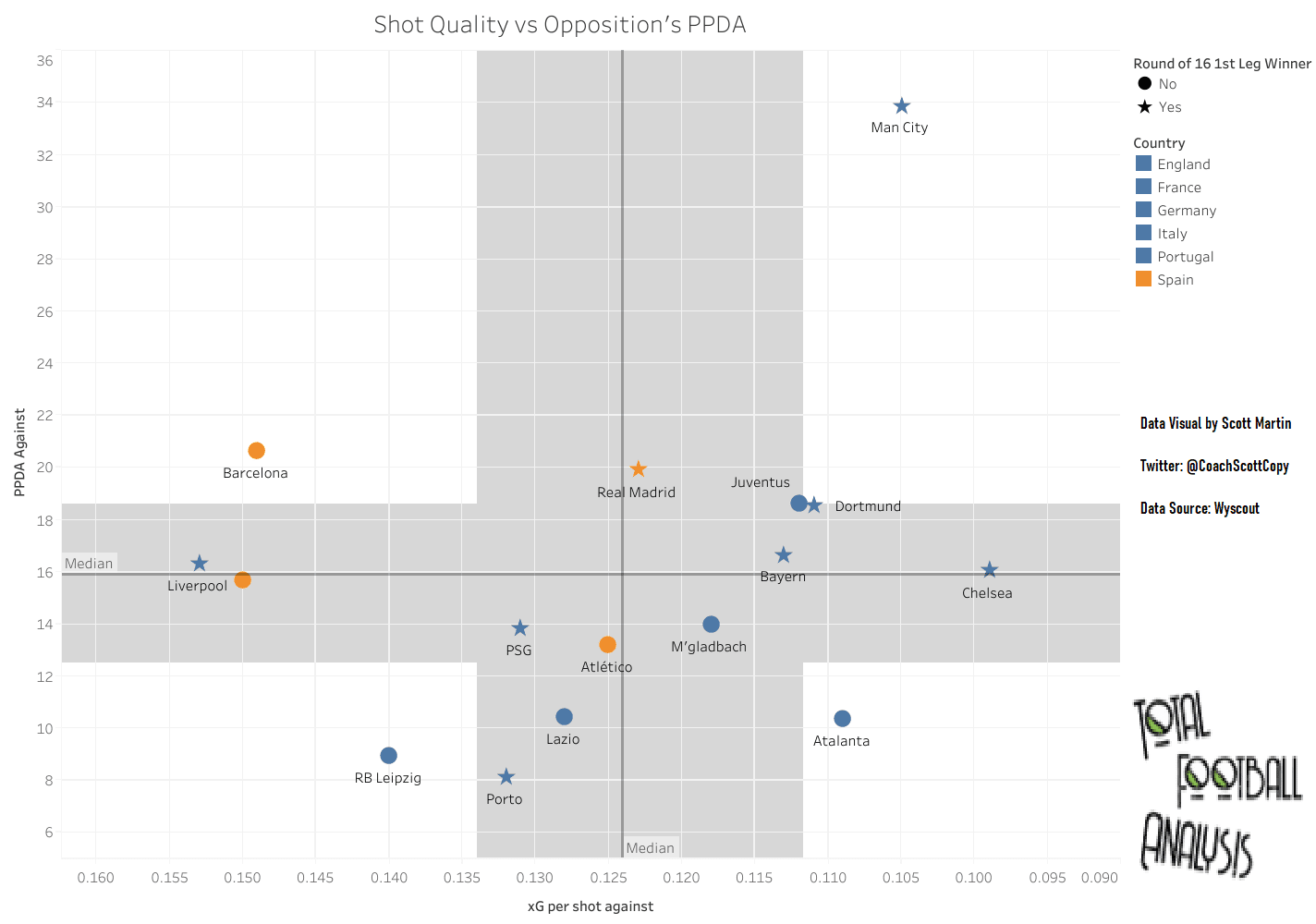
There’s a little bit of a transition from final third attacking to the quality of the chances conceded to the opposition, but for good reason as they’re deeply intertwined.
After Manchester City’s absolutely absurd PPDA against, we find Barcelona and Real Madrid hovering right around 20. Sevilla is right at the median whereas Atlético Madrid doesn’t have to deal with a low block quite as often. As you recall, they are prone to turnovers in the defensive and middle thirds of the pitch, so opponents are more willing to press them.
The first thing this chart tells us is that opponents are quick to drop off into middle and low blocks against Barcelona and Real Madrid. Given their press resistance, there’s very little point in pressing them higher up the pitch. Looking at the five teams with the highest PPDA against, Manchester City’s stacked and relatively healthy roster has really not had much of an issue beating the low block. However, Barcelona, Real Madrid, Juventus and Borussia Dortmund have all struggled in this regard, both in the Champions League and domestically.
As opponents drop off into their low blocks, we are seeing La Liga teams break from there rest defence to push numbers higher up the pitch in an effort to break the low block. Barcelona and Sevilla are especially vulnerable in this area, which is indicated by their xG per shot against. Those two join Liverpool at the bottom of the data set, offering the opposition high-quality chances on goal. So while Barcelona, in particular, is still putting up some very respectable attacking numbers, we do find that they are overcompensating defensively. That’s largely tied to their issues and beating the low block. Taking the attacking initiative is a noble endeavour, but we are seeing them stagnate in the final third of the pitch, which, in turn, is forcing La Liga’s teams to overcompensate with their rest defence, leaving themselves vulnerable to the opponent’s direct attacks and transitional moments.
Defensive issues?
So let’s move on to the other side of the equation, defensive production. Knowing that La Liga clubs are performing well in most attacking categories, even exceptionally well in some, we’ve seen the impact their attacks can have higher up the pitch. Further, we’ve seen how overcompensation in the final third of the pitch can leave a team vulnerable in defensive transitions. If you’re not sure if the data meets the eye, just go back and watch PSG’s frontline obliterate Barcelona.
To gauge the four La Liga teams’ defensive efforts, we’ll look at their opponent’s counterattacks and positional attacks with shots. The below graph gives the success percentage of these attacks. Consistent throughout the article, top performers are in the top right-hand corner of the graph and the worst performers are on the bottom left.
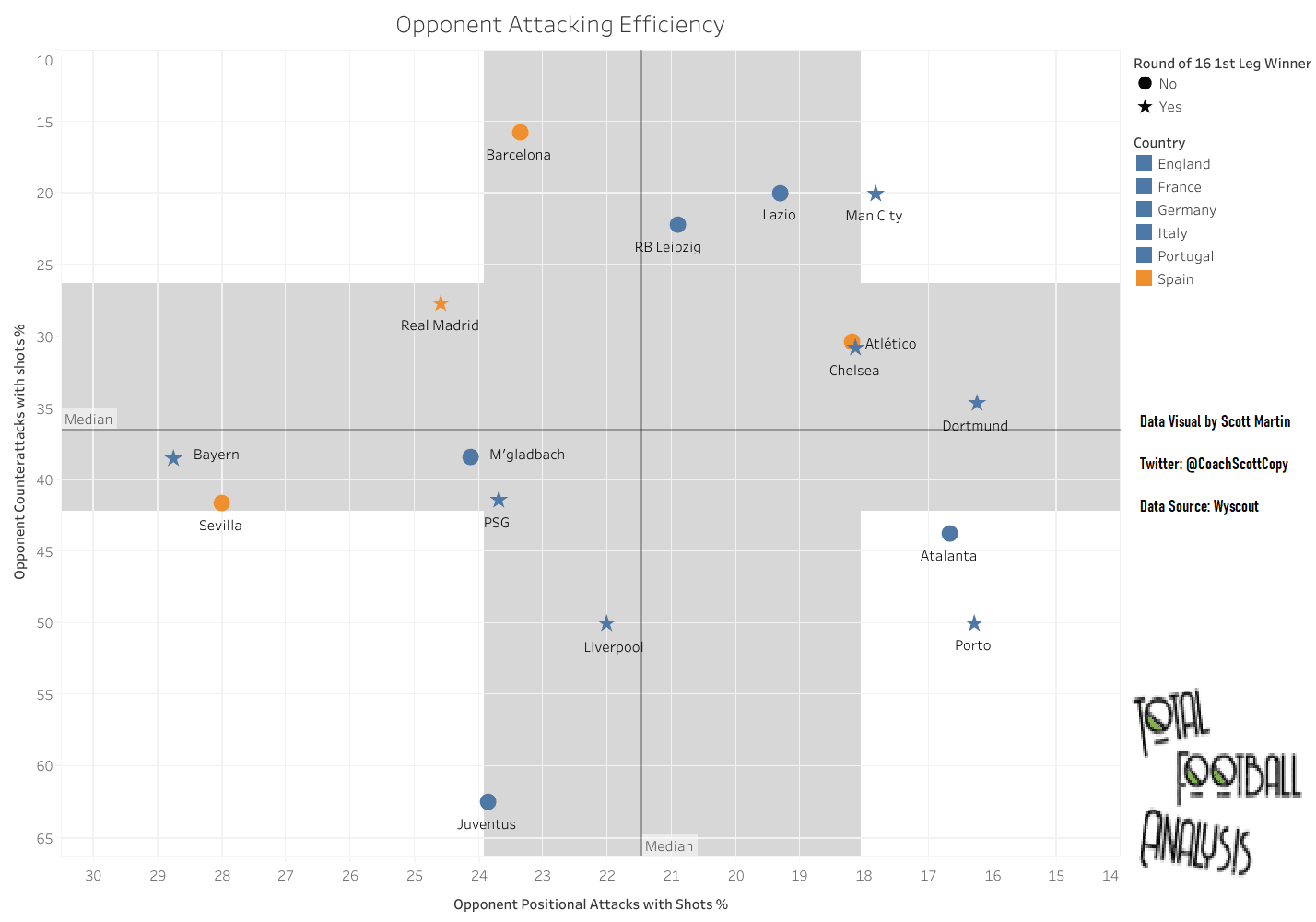
Typically defensively solid in La Liga, we see that Sevilla has been vulnerable against both counterattacks and positional attacks. They’ve greatly struggled in these areas, which gives some insight into their over commitments in attack.
To no one’s surprise, Atlético rates as the top defensive team from La Liga, but, even there, they’re neck-and-neck with Chelsea and still some ways off from the top spot in each category, coming in at 6th in both statistics.
Meanwhile, Barcelona rates as the top team in defending against the counterattack and Real Madrid is still well above average in fifth. However, both rate below average in defending against positional attacks.
So where to do La Liga teams recover the ball?
With the exception of Atlético Madrid, we don’t see many low recoveries, which is again a credit to their press resistance at the back. Protecting the ball in the buildup phases leads to fewer needs to recover the ball in the defensive third.
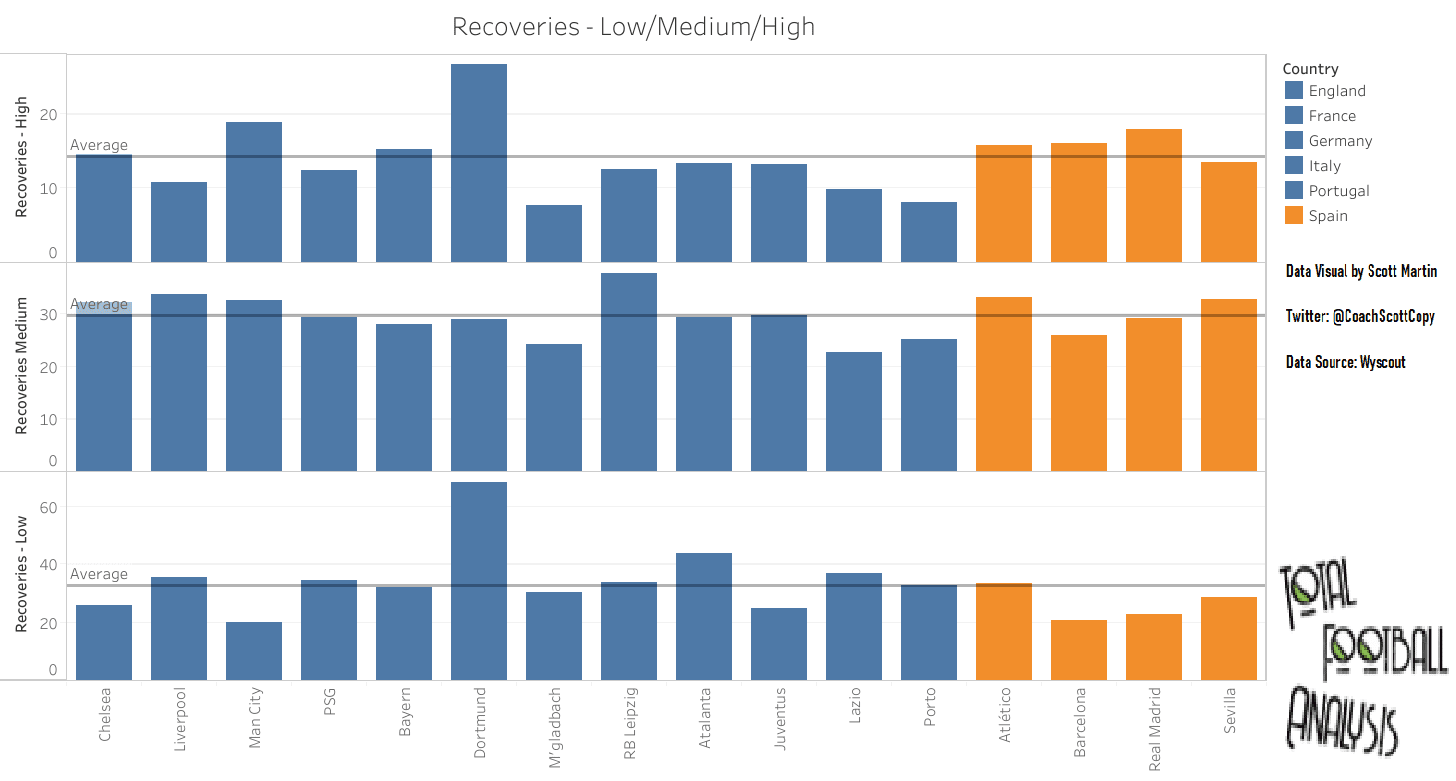
In terms of medium recoveries, we do find Atlético Madrid and Sevilla are well above average in recovering the ball in the middle third. Real Madrid isn’t far behind, coming in pretty close to the median. In terms of high recoveries, Sevilla is the one team to record a below-average total.
This does give us an indication that La Liga teams, first, enjoy a great deal of possession in the final third of the pitch and, secondly, that they are quick to counterpress. However, when that counterpress does fail, we do see that they are not well-positioned to make middle or low recoveries. Although Real Madrid and Barcelona defend against counterattacks fairly well, the one or two counterattack shots that they allow per game tend to be lethal.
As we turn our attention to the final visual, our analysis shows how opponents enter the box. Much like our earlier chart, this one gauges entries into the box via runs or crosses.
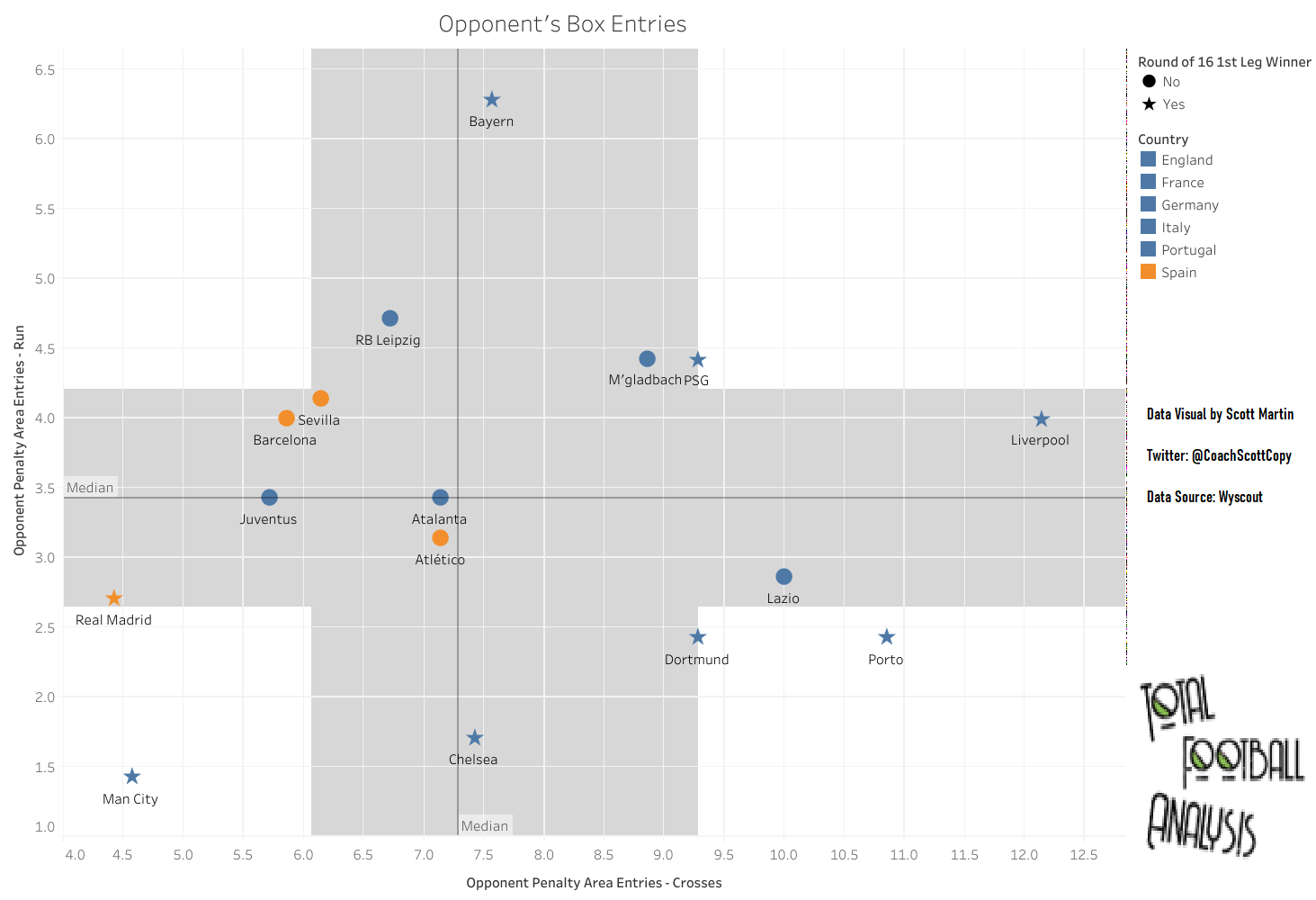
Although Atlético’s very near the median in both categories, we do see that Sevilla and Barcelona have a tendency to let the opposition run into the box and don’t have to deal with many crosses. Real Madrid it’s actually in great shape defensively, rating fifth in opponent box entries through runs while defending against the fewest crosses.
Of the nine charts in this article, this is probably the trickiest one to assess. From an objective standpoint, Manchester City and Real Madrid offer the best combination.
However, when dealing with box entries, it is typically best to concede more crosses than runs. Although runs into the box might initiate in the wings or the half space, the player entering the box will typically have full control and a definitive purpose as he enters the box. Crosses have a fairly low success rate anyway, so if you’re playing strictly by the odds, it’s better to funnel opponents into the wings and force them to cross rather than run or dribble into the box. We’ve already seen that Sevilla and Barcelona allow high xG shots to their opponents. When you look at the way their opposition accesses the box, you do get the sense that these two are not doing enough to disrupt the opposition’s attacks, which bears out on the film.
Conclusion
So, is Spain’s Champions League decline signalling a shift in power?
When looking at La Liga’s four competitors in this rendition of the UEFA Champions League, the spectrum in philosophies is massive, so we can’t take a one-size-fits-all approach here.
With regards to Barcelona and Sevilla, all indicators point to attacking over-compensations leaving the clubs vulnerable at the back. For Atlético Madrid, The attacking issues remain, which is paired with a drop in their defensive stoutness. Of the four, Real Madrid offers the best balance and are La Liga’s best bet to make a deep run. Zinedine Zidane has been missing a starting XI worth of players for a couple of months now. Should those players return soon and find enough form to see off Atalanta in the second leg, their progression may hinge upon their quarterfinal draw. That said, it’s their tactical balance that will carry them.
Looking at the league with a broader brush, there’s no denying that this is a time of transition after 15 years of European dominance. Cristiano Ronaldo is gone and Lionel Messi is the last obstacle in Barcelona’s rebuild with their excellent young core.
With the game trending towards more direct attacks and the enhanced importance of transitional moments, we are seeing issues emerge with the penalty box entries, quality of shots and rest defence. To some extent, you get the sense that opponents are waiting for the Spanish sides to overcommit in attack, then punish them.
Real Madrid’s tactical balance gives him a chance for a minimum of a quarter-final run, but their issues in the final third could come back to haunt them, especially against better opposition. Meanwhile, for Atlético, we haven’t seen them fully commit to a more balanced system. The timid approach against Chelsea was in an indictment of the progress we assumed from Diego Simeone’s men.
In the knockout stages of the Champions League, progression is typically dependent on extraordinary systems or extraordinary players, particularly the goal scorers. While there’s still plenty of talent in La Liga, tactical balance and consistency are major issues.
Heading into the second leg of the Round of 16, Real Madrid seems a pretty good bet to progress, but the odds are against the other three. Don’t be surprised if either Atlético or Sevilla progress, but, again, La Liga clubs have put themselves in a bind. Whether this is a temporary lapse or a long-term adjustment remains to be seen, but suffice it to say that Europe’s powerhouses are benefiting from this stagnation of La Liga’s top teams.





Comments